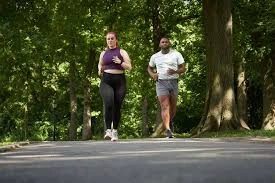
Which is Better for Weight Loss: Walking or Running?

People greatly respect their health, so technology has become a primary tool for weight loss. Wearable fitness trackers could be your closest friend whether you’re just starting or now live healthier.
Table of Contents
Introduction
Weight loss is a topic that has garnered widespread attention in recent years, given the growing concern over obesity and its associated health risks. While there are various strategies for losing weight, exercise remains a fundamental component of most weight loss plans. Walking and running are two of the most accessible and effective forms of exercise, and they can be incorporated into daily routines with relative ease.
The decision between walking and running for weight loss isn’t a one-size-fits-all scenario. Different individuals have different needs, fitness levels, and preferences. In this article, we will explore the pros and cons of both walking and running as they relate to weight loss, providing you with the knowledge you need to make an informed decision about which activity aligns best with your weight loss goals.

The Science of Weight Loss

Before we delve into the specifics of walking and running for weight loss, it’s crucial to understand the science behind weight loss itself. Weight loss is primarily driven by a simple concept: you need to expend more calories than you consume. This is known as a calorie deficit. When you create a calorie deficit through diet and exercise, your body starts to use stored fat for energy, resulting in weight loss.
In essence, weight loss is a balance between calorie intake and calorie expenditure. To lose weight effectively and sustainably, you must either reduce your calorie intake, increase your calorie expenditure through physical activity, or, ideally, combine both approaches.
The Benefits of Walking for Weight Loss

When it comes to weight loss, many people often associate it with high-intensity workouts and sweat-drenched gym sessions. However, the simple act of walking, an everyday activity for most of us, holds a treasure trove of benefits when it comes to shedding pounds and improving overall health. In this detailed exploration, we will uncover the numerous advantages of walking as an exercise for weight loss.
Accessibility and Inclusivity
Walking stands out as a shining example of an exercise that’s incredibly accessible and inclusive. It doesn’t discriminate based on age, fitness level, or physical condition. Whether you’re a sprightly youth or a senior citizen, an elite athlete or a complete novice, walking is a form of exercise that welcomes everyone with open arms.
The beauty of walking lies in its simplicity. You don’t need special equipment or a membership to a fancy gym. All you require is a comfortable pair of shoes and the open road, making it an ideal choice for individuals who are just starting their fitness journey or those who may have physical limitations that restrict them from engaging in more strenuous activities.
Low Impact
One of the standout features of walking as an exercise for weight loss is its low-impact nature. Low-impact exercises are those that exert minimal stress on your joints, and walking epitomizes this quality. This makes it an excellent choice for individuals with joint issues, arthritis, or anyone recovering from injuries.
Contrast this with higher-impact activities like running, which can be harsh on the joints, potentially leading to discomfort or injury. The gentle, fluid motion of walking allows individuals to engage in regular exercise without worrying about the wear and tear on their bodies.
Sustainability
Sustainability is the secret ingredient in the recipe for long-term weight loss success, and walking has it in spades. Sustainable exercise routines are those that can be maintained over extended periods without causing physical or mental burnout. Walking, with its inherent simplicity and low-intensity nature, fits this bill perfectly.
People are more likely to adhere to a walking routine because it’s less physically demanding than running or other high-intensity workouts. Additionally, walking can be effortlessly woven into daily life. Commuting to work on foot, taking a post-dinner stroll, or going for a leisurely walk in the park are all enjoyable ways to incorporate walking into your routine, ensuring that you can stick with it over the long haul.
Fat Burning
While walking may not torch calories at the same rate as more intense exercises like running or high-intensity interval training (HIIT), it is nonetheless an effective way to promote fat loss. The key lies in maintaining a brisk pace during your walks.
Walking at a pace that elevates your heart rate and engages your muscles triggers your body to utilize stored fat for energy. Over time, this can lead to a gradual but steady reduction in body fat, helping you move closer to your weight loss goals.
Mental Health Benefits
Weight loss isn’t solely about burning calories and shedding pounds; it’s also about achieving a holistic sense of well-being. The mental health benefits of walking are a testament to its power as an exercise for weight loss and overall health.
Engaging in physical activity, such as walking, releases endorphins, the body’s natural mood enhancers. These chemicals can help reduce stress, anxiety, and depression, providing a welcome boost to your emotional well-being. When you’re feeling good mentally, it’s easier to stay committed to your weight loss journey and make healthier choices in your diet and lifestyle.
Lower Risk of Overuse Injuries
For those concerned about the risk of overuse injuries, walking offers a safer alternative compared to higher-impact activities like running. Overuse injuries can be frustrating setbacks on the road to weight loss, as they can disrupt your exercise routine and slow down your progress.
Walking’s low-impact nature minimizes the repetitive stress on your joints, reducing the likelihood of issues like shin splints, stress fractures, and tendonitis. This means you can stay on track with your weight loss plan with a lower risk of sidelining injuries.
Better for Beginners
Embarking on a weight loss journey can be intimidating, especially if you’re new to exercise or have been leading a sedentary lifestyle. Walking serves as an ideal gateway to fitness for beginners, allowing them to establish a solid foundation gradually.
The gentleness of walking makes it less daunting than more intense activities. Beginners can start at their own pace, gradually increasing their walking duration and intensity as their fitness level improves. This gradual progression not only reduces the risk of injury but also builds confidence and stamina, setting the stage for more advanced exercises if desired.
Therefore, walking is a powerhouse of an exercise when it comes to weight loss and overall health. Its accessibility, low-impact nature, sustainability, and mental health benefits make it a versatile and effective choice for individuals of all backgrounds and fitness levels. Whether you’re looking to shed a few pounds, maintain a healthy weight, or simply enhance your well-being, walking can be your trusted companion on the journey to a healthier you.
The Drawbacks of Walking for Weight Loss

While walking unquestionably boasts numerous advantages for weight loss and overall health, it’s essential to acknowledge that it may not be the optimal choice for everyone or for all weight loss goals. In this section, we’ll delve into some of the drawbacks of relying solely on walking as your primary exercise for shedding pounds.
Lower Calorie Burn
One of the primary limitations of walking as a weight loss exercise is its relatively lower calorie burn compared to more high-intensity activities like running. While walking can certainly help you expend calories, the rate at which you burn them is significantly lower when compared to more strenuous exercises.
This means that to achieve the same calorie expenditure as running, you may need to dedicate a more extended period to your walking sessions. For individuals with busy schedules and limited time for exercise, this can be a significant drawback. The time commitment required for substantial calorie burn through walking alone may not align with the demands of modern life.
Slower Results
The lower intensity of walking can lead to slower weight loss results when compared to more vigorous workouts like running or high-intensity interval training (HIIT). Weight loss occurs when you create a calorie deficit, burning more calories than you consume. Given that walking burns calories at a gentler pace, it may necessitate a more extended timeframe to achieve noticeable results.
For individuals who have a substantial amount of weight to lose or those who are looking for rapid changes in their physique, relying solely on walking might not provide the swiftness of transformation they desire. The gradual nature of weight loss through walking can be disheartening for those seeking more immediate gratification.
Plateaus
Another potential drawback of walking for weight loss is the possibility of hitting plateaus. As your body adapts to a regular walking routine, the effectiveness of the exercise can diminish over time. This adaptation phenomenon, known as the “plateau effect,” is a common occurrence in fitness.
To continue seeing meaningful weight loss results with walking, you may need to continually increase the duration, intensity, or frequency of your walks. This progressive approach can be challenging for some individuals, particularly those who are already pushing their physical limits or those who have limited opportunities to increase the exercise’s intensity.
Breaking through plateaus often requires creativity and variety in your workouts, such as incorporating hills, adding weights, or adjusting your pace, which may not be as straightforward with walking as it is with more versatile forms of exercise.
Limited Muscle Engagement
While walking engages a variety of muscle groups, particularly those in the lower body, it doesn’t offer the same level of muscle development as activities like running or resistance training. Running, for instance, activates muscles not only in the legs but also in the core and upper body to a more substantial extent.
The limited muscle engagement in walking means that it may not contribute as significantly to muscle toning and definition as other exercises do. While weight loss often involves shedding excess fat, it’s also crucial to maintain and build lean muscle mass. Muscle not only enhances your metabolic rate, helping you burn more calories at rest, but it also contributes to a more sculpted and toned physique.
Therefore, individuals who seek not only weight loss but also improved muscle definition may find that walking alone does not sufficiently address their fitness goals.
Remember, while walking undeniably offers a host of advantages for weight loss and overall health, it’s essential to be aware of its limitations. Lower calorie burn, slower results, the potential for plateaus, and limited muscle engagement are some of the drawbacks to consider when deciding whether walking is the right primary exercise for your weight loss journey.
However, it’s crucial to emphasize that walking can still be a valuable component of a comprehensive weight loss plan. Many individuals combine it with other exercises, such as running, resistance training, or high-intensity interval workouts, to create a well-rounded fitness regimen that addresses both the drawbacks and advantages of walking, ensuring a more balanced and effective approach to achieving their weight loss goals.
Note: There might be affiliate links mentioned here. We may receive a commission if you purchase a product through an affiliate link. There is no additional charge for you. Please do your own research before making any online purchases.
The Benefits of Running for Weight Loss

Running, often revered as the ultimate cardiovascular workout, holds a special place in the realm of exercise for weight loss. This higher-intensity aerobic activity comes with a unique set of advantages that make it a go-to choice for those seeking to shed pounds and improve overall fitness. In this comprehensive exploration, we will uncover the multitude of benefits that running offers as an exercise for weight loss.
High Calorie Burn
One of the standout features of running is its exceptional calorie-burning potential. When it comes to torching calories per minute, few exercises can rival the efficiency of running. The high intensity of this activity translates to a substantial calorie expenditure during your workouts.
If you’re looking to maximize calorie burn and expedite your weight loss journey, running can be a potent ally. Its capacity to incinerate calories at an accelerated rate means that you can achieve significant results in a shorter timeframe compared to lower-intensity exercises like walking.
Efficient Time Use
In today’s fast-paced world, time is a precious commodity. Running, with its ability to burn calories quickly, allows you to make the most of your limited exercise time. This efficiency is a boon for individuals with hectic schedules who are seeking effective ways to fit exercise into their daily routine.
For those who find themselves constantly on the go and unable to devote extended hours to their workouts, running can be a lifesaver. A 30-minute run can provide a substantial calorie burn and contribute significantly to your weight loss goals, making it an ideal choice for those with time constraints.
EPOC (Excess Post-Exercise Oxygen Consumption)
Running has a hidden treasure known as Excess Post-Exercise Oxygen Consumption (EPOC) or the “afterburn effect.” This phenomenon is a metabolic gift that keeps on giving long after your run has concluded.
After a high-intensity run, your body remains in a heightened state of calorie burning, as it works to replenish oxygen stores, repair tissues, and restore physiological functions to their pre-exercise state. This post-exercise calorie burn can last for hours, or even days, depending on the intensity and duration of your run. In essence, running continues to torch calories even when you’re at rest, which is a significant asset for weight loss.
Improved Cardiovascular Fitness
While weight loss is a primary goal for many individuals, it’s crucial not to overlook the broader implications of exercise on overall health and well-being. Running excels in this department by significantly enhancing cardiovascular fitness.
Regular running sessions elevate your heart rate and challenge your cardiovascular system, leading to improved endurance and aerobic capacity. A robust cardiovascular system not only facilitates better oxygen transport and nutrient delivery throughout the body but also lowers the risk of heart disease, stroke, and other cardiovascular issues.
Muscle Engagement
Running is a full-body workout that engages a diverse array of muscles throughout your body. While it primarily targets the muscles in your legs, it also activates those in your core, upper body, and even your back. This comprehensive muscle engagement contributes to improved muscle tone and definition.
Contrast this with walking, which, while an excellent exercise in its own right, predominantly targets the lower body muscles. Running’s ability to activate a broader range of muscle groups is a significant advantage for individuals seeking not only weight loss but also a more sculpted and toned physique.
Potential for High-Intensity Intervals
Running’s versatility extends to its compatibility with high-intensity interval training (HIIT), a workout strategy that has gained immense popularity in recent years. HIIT involves alternating between short bursts of high-intensity exercise and brief recovery periods. This approach has been shown to be remarkably effective for burning fat and improving overall fitness.
Running provides an ideal platform for implementing HIIT workouts. You can incorporate intense sprints or uphill runs during your sessions, interspersed with periods of slower jogging or walking to recover. This not only elevates your calorie burn during the workout but also triggers the EPOC effect, resulting in additional calorie expenditure long after you’ve finished your run.
Therefore, running emerges as a heavyweight champion in the arena of weight loss exercises, thanks to its high calorie burn, time efficiency, EPOC effect, cardiovascular benefits, muscle engagement and potential for high-intensity intervals. It offers a comprehensive approach to weight loss that extends beyond mere calorie expenditure, contributing to improved fitness and overall health.
However, it’s essential to approach running with care, especially if you’re new to the activity or have any underlying health concerns. Consult with a healthcare provider or fitness professional to create a safe and effective running plan that aligns with your weight loss goals and physical condition. With proper guidance and dedication, running can be a potent tool in your weight loss arsenal, propelling you toward your desired fitness destination.
The Drawbacks of Running for Weight Loss

Running, often celebrated as a dynamic and highly effective exercise for weight loss, does come with its set of drawbacks that may not align with everyone’s needs or preferences. While it undoubtedly offers numerous advantages, it’s essential to consider these limitations when making an informed decision about incorporating running into your weight loss plan.
High Impact
One of the most prominent drawbacks of running as an exercise for weight loss is its high-impact nature. Running places a substantial amount of stress on the joints, particularly the knees and hips. This is due to the repeated pounding of the feet against the ground, which can generate significant impact forces.
For individuals with preexisting joint issues, arthritis, or those who are prone to injuries, the high-impact nature of running can be a major concern. Without proper care and attention to form and footwear, this can lead to overuse injuries, including:
- Shin Splints: Pain and inflammation in the front part of the lower leg.
- Stress Fractures: Tiny cracks in bones due to repetitive stress.
- Tendonitis: Inflammation of tendons, commonly affecting the Achilles tendon.
- Runner’s Knee: Pain around the kneecap due to overuse.
These injuries can not only be painful but can also disrupt your weight loss journey and overall fitness routine. It’s essential to prioritize joint health and take precautions to minimize the risk of these injuries when engaging in running.
Learning Curve
Running may seem like a straightforward activity, but achieving proper form and technique can be more complex than it appears. Maintaining the correct form is essential to prevent injuries and maximize the benefits of running for weight loss.
For beginners, there can be a learning curve involved in mastering the art of running with proper form. Proper running form includes aspects like stride length, foot strike, posture, and arm movement. Incorrect form can lead to discomfort, inefficiency, and an increased risk of injury.
To address this drawback, beginners are encouraged to seek guidance from experienced runners or fitness professionals who can provide tips, feedback, and recommendations on how to run with proper form. Investing time in learning the basics of running technique can significantly enhance your running experience while minimizing the risk of injury.
Intimidation Factor
The intensity of running can be intimidating for individuals who are new to exercise or those who may not be in good cardiovascular shape. Unlike walking or lower-intensity activities, running demands a higher level of cardiovascular fitness and stamina.
For someone who hasn’t engaged in regular physical activity or has been leading a sedentary lifestyle, the prospect of starting a running routine can be daunting. The rapid increase in heart rate and breathing rate during a run can be overwhelming for beginners, potentially deterring them from adopting running as their primary exercise for weight loss.
Overcoming this intimidation factor often requires a gradual and progressive approach. Starting with walk-run intervals, where you alternate between walking and running, can be an effective strategy to build endurance and confidence over time. Additionally, setting achievable goals and focusing on gradual improvements can help alleviate the intimidation factor associated with running.
Risk of Burnout
The intensity of running, if not managed carefully, can lead to burnout or overtraining. Overtraining occurs when individuals push themselves too hard, too frequently, without providing adequate time for rest and recovery. This can result in physical and mental fatigue, performance plateaus, and a heightened risk of injuries.
The desire to achieve weight loss goals quickly can sometimes lead individuals to overcommit to running without allowing their bodies to adapt and recover adequately. Burnout can hinder weight loss progress, as it may necessitate extended breaks from exercise, disrupting the consistency needed for successful weight loss.
To mitigate the risk of burnout, it’s crucial to incorporate rest days into your running routine, listen to your body’s signals, and pay attention to signs of overtraining, such as persistent fatigue, declining performance, and mood disturbances. Cross-training with lower-impact activities like swimming or cycling can also provide a welcome break from the high impact of running while maintaining overall fitness.
Therefore, while running offers a wealth of benefits for weight loss, including high calorie burn, efficiency, EPOC, improved cardiovascular fitness, muscle engagement, and the potential for high-intensity intervals, it’s vital to acknowledge its drawbacks. These drawbacks include the high-impact nature of running, the learning curve associated with proper form, the intimidation factor for beginners, and the risk of burnout.
To make running a safe and effective part of your weight loss plan, consider addressing these drawbacks with strategies such as proper form guidance, gradual progression, and a balanced approach that incorporates rest days and cross-training. By doing so, you can harness the power of running while minimizing its potential drawbacks, ensuring a sustainable and successful weight loss journey.
Which Is Better for Weight Loss: Walking or Running?

In the quest for weight loss and improved fitness, the choice between walking and running often emerges as a pivotal decision. Both activities offer unique advantages and drawbacks, and determining which one is better suited to your goals requires careful consideration. In this comprehensive analysis, we will dissect the scenarios in which walking or running may be the preferable choice for your weight loss journey.
Walking May Be Better If
1. You’re a Beginner
- Starting an Exercise Journey: For individuals who are new to exercise or have been leading a predominantly sedentary lifestyle, walking serves as an inviting gateway to physical activity. It allows beginners to initiate their fitness journey at a manageable pace, easing their bodies into the rhythm of regular exercise without overwhelming them.
- Building a Foundation: Walking provides the opportunity to build a solid foundation of fitness and stamina gradually. This gradual progression enables individuals to acclimate to the demands of exercise, setting the stage for more challenging activities in the future. It’s an excellent way to establish the habit of regular exercise, which is crucial for long-term success in weight loss and overall health.
- Reduced Risk of Injury: The low-impact nature of walking translates to a reduced risk of injury compared to higher-impact activities like running. It places minimal stress on the joints, making it a safer choice for individuals concerned about joint issues, arthritis, or those recovering from injuries. Walking can be an effective means of staying active without exacerbating joint pain or risking setbacks in the healing process.
2. You Prefer a Sustainable Routine
- Long-Term Commitment: Sustainability is a cornerstone of successful weight loss and overall health. Many people embark on weight loss journeys with the intention of making lasting lifestyle changes. Walking excels in this department as it offers a sustainable exercise routine that can be maintained over the long haul. It’s less physically demanding than running, making it an activity that people are more likely to stick with consistently.
- Integration into Daily Life: Walking’s adaptability and simplicity allow it to be seamlessly integrated into daily routines. You can choose to walk to work, take a leisurely stroll after dinner, or explore nature on a weekend hike. The ease with which walking can be incorporated into everyday life increases the likelihood of maintaining an active lifestyle over time.
3. You Seek Mental Health Benefits
- Holistic Well-Being: Weight loss is not solely about the numbers on the scale; it encompasses overall well-being, including mental health. Walking outdoors, particularly in natural settings, can be a therapeutic experience that promotes emotional and mental well-being. The calming effects of nature and the opportunity to clear one’s mind while walking can reduce stress, anxiety, and depression, indirectly supporting weight loss efforts by fostering a positive mental state.
- Reducing Stress: Stress management is a critical component of any weight loss journey. Stress can lead to emotional eating and hinder progress. Walking provides an avenue for stress reduction, offering individuals a chance to unwind and decompress from the demands of daily life.
4. Time is Not a Constraint
- Leisurely Pace: For those with the flexibility to dedicate more time to exercise and who prefer longer, more leisurely sessions, walking can be an effective choice. While it may burn fewer calories per minute than running, extended walking sessions can still contribute significantly to weight loss. The emphasis here is on enjoying the journey and maintaining consistency.
Running May Be Better If
1. You Want Faster Results
- Accelerated Calorie Burn: Running stands out as a powerhouse when it comes to calorie burn. It burns more calories per minute than walking due to its higher intensity. If you’re looking to expedite your weight loss journey and achieve results more quickly and efficiently, running can help you reach your goals in a shorter timeframe.
- Time Efficiency: In today’s fast-paced world, time is often a limited resource. Running’s ability to incinerate calories rapidly makes it a time-efficient option for individuals with busy schedules. If you need to maximize calorie expenditure in a limited amount of time, running can be an excellent choice.
2. You Have Cardiovascular Goals
- Improving Cardiovascular Fitness: While weight loss is a primary goal for many, overall health should not be overlooked. Running at a moderate to high intensity significantly improves cardiovascular fitness. This is essential not only for weight loss but also for reducing the risk of heart disease, improving endurance, and enhancing overall health and longevity.
- Cardiovascular Benefits: Running elevates your heart rate and challenges your cardiovascular system, leading to better oxygen transport, improved nutrient delivery, and enhanced circulation. The cardiovascular benefits derived from running can have far-reaching positive effects on your health beyond just weight loss.
3. You’re Comfortable with High Intensity
- Embracing High Intensity: Running is synonymous with high-intensity workouts. If you’re comfortable with pushing your physical limits and engaging in vigorous exercise, running can be a suitable choice. It allows you to challenge yourself both mentally and physically, providing a sense of accomplishment and boosting confidence.
- Potential for High-Intensity Intervals: Running’s high intensity also opens the door to incorporating high-intensity interval training (HIIT). HIIT involves alternating between short bursts of intense running and periods of recovery. This approach has been shown to be highly effective for burning fat and improving fitness.
4. You Seek Muscle Tone
- Comprehensive Muscle Engagement: Running engages a broader range of muscles compared to walking. While walking primarily targets the lower body muscles, running activates the muscles in the legs, core, and upper body to a greater extent. This comprehensive muscle engagement contributes to improved muscle tone and definition.
- Aesthetic Goals: For individuals who are not only focused on weight loss but also seek a toned and sculpted physique, running can align with their aesthetic goals. The muscle engagement and calorie burn associated with running can contribute to a more defined and athletic appearance.
5. Time is Limited
- Optimizing Exercise Time: In a world where schedules are often jam-packed, optimizing exercise time becomes crucial. Running can be a more time-efficient option for calorie expenditure compared to walking. In a relatively short duration, a high-intensity run can provide a substantial calorie burn, allowing you to make the most of your limited exercise time.
Therefore, the choice between walking and running for weight loss is not one-size-fits-all. It depends on various factors, including your fitness level, physical condition, goals, and personal preferences. Both activities offer unique advantages and drawbacks, and the key is to align your choice with your individual circumstances.
Remember that consistency, sustainability, and enjoyment are paramount in any successful weight loss plan. Whether you choose walking, running, or a combination of both, the critical factor is to stay active, create a calorie deficit through a balanced diet, and make gradual, sustainable progress toward your weight loss goals. Moreover, consider consulting with a fitness professional or healthcare provider to receive personalized guidance and recommendations that cater to your specific needs and objectives. Ultimately, the journey to weight loss is a personal one, and the path you choose should be one that resonates with you and helps you achieve your desired outcomes while prioritizing your health and well-being.
Combining Walking and Running for Weight Loss

The choice between walking and running for weight loss is not an exclusive one. Instead, many individuals discover that the most effective approach involves a combination of both activities, strategically integrated into a balanced workout routine. By merging walking and running, you can harness the unique benefits of each while maximizing your weight loss potential. Here’s how you can incorporate this dynamic approach into your weight loss plan:
Interval Training
Interval training is a potent strategy for combining the benefits of both walking and running. It involves alternating between periods of high-intensity exercise (running) and lower-intensity recovery (walking). This approach can significantly boost calorie burn while providing opportunities for active recovery. Here’s how to implement interval training effectively:
1. Walking and Running Intervals
- Begin your workout with a brisk walk to warm up and prepare your muscles.
- Transition into a short sprint or faster-paced running segment for a specific duration or distance.
- After the running interval, return to a brisk walk or slower pace to recover.
- Repeat this cycle, alternating between walking and running intervals throughout your session.
2. Adjust Intensity
- Customize the intensity of your intervals based on your fitness level and goals. You can gradually increase the duration or speed of your running intervals as your fitness improves.
3. Track Progress
- Monitor your progress by recording the duration, distance, or speed of your running and walking intervals. Over time, you’ll likely notice improvements in your endurance and calorie burn.
- Interval training not only elevates your calorie burn during the workout but also triggers the Excess Post-Exercise Oxygen Consumption (EPOC) effect, leading to additional calorie expenditure in the hours following your workout.
Alternate Days
Another effective strategy is to alternate between walking and running on different days of the week. This approach allows you to vary your exercise routine while capitalizing on the unique advantages of each activity:
1. Brisk Walking Days
- On certain days, focus on brisk walking for a more extended duration. This can be especially beneficial for building endurance, improving cardiovascular health, and enhancing sustainability.
- Emphasize covering distances or maintaining a brisk pace, depending on your fitness level and goals.
2. Running Days
- Reserve specific days for running to intensify your calorie expenditure and engage in high-intensity cardiovascular workouts.
- These running sessions can be shorter in duration but higher in intensity compared to your walking days.
- This alternating approach not only keeps your exercise routine engaging and diverse but also allows for active recovery on walking days, reducing the risk of overuse injuries associated with continuous high-impact running.
Cross-Training
Incorporating cross-training is another way to combine walking and running effectively within your weight loss plan. Cross-training involves adding variety to your exercise routine by including different forms of physical activity. Here’s how you can utilize cross-training:
1. Active Recovery
- On your rest days or in between more intense running sessions, engage in walking as a form of active recovery.
- Walking provides a low-impact alternative that allows your muscles and joints to recuperate while keeping you active and aiding in weight loss.
2. Variety and Fun
- Incorporate various activities such as swimming, cycling, or even dancing into your routine. These activities can break the monotony of a consistent walking or running regimen and keep your workouts enjoyable.
3. Reduce Overuse Risk
- Cross-training helps reduce the risk of overuse injuries associated with repetitive movements. By diversifying your workouts, you can maintain consistency in your exercise routine while minimizing the likelihood of injuries.
Long Walks
Long walks can serve as an integral component of your combined walking and running approach. These extended, leisurely walks are ideal for days when you have more time to dedicate to your exercise routine. Here’s how long walks can contribute to your weight loss plan:
1. Therapeutic and Relaxing:
- Long walks provide an opportunity to unwind and de-stress, contributing to your overall well-being. Reduced stress levels can positively impact your weight loss efforts by mitigating emotional eating and improving sleep quality.
2. Distance and Sustainability:
- Use these walks to focus on covering greater distances or maintaining a sustainable pace. The emphasis is on endurance and enjoying the journey, which can enhance your commitment to long-term fitness.
3. Social and Enjoyable:
- Invite friends or family to join you on long walks, making them social and enjoyable outings. Social support can be a motivating factor in staying consistent with your exercise routine.
- Incorporating long walks provides a holistic approach to your weight loss journey, addressing not only the physical but also the mental and emotional aspects of well-being.
Therefore, the combination of walking and running can be a highly effective strategy for weight loss. It allows you to maximize calorie burn, diversify your workouts, reduce the risk of overuse injuries, and cater to your individual fitness level and preferences. Whether you choose interval training, alternate days, cross-training, or long walks, the key is to create a well-rounded routine that promotes consistency, sustainability, and overall health. By harnessing the benefits of both walking and running, you can embark on a balanced and rewarding weight loss journey that aligns with your goals and contributes to your long-term well-being.
FAQs (Frequently Asked Questions)
Q1: Is walking an effective exercise for weight loss?
A1: Yes, walking can be highly effective for weight loss. While it may not burn calories as rapidly as high-intensity workouts, it promotes gradual and steady fat loss when done consistently.
Q2: How often should I walk to see weight loss results?
A2: Aim for at least 150 minutes of moderate-intensity walking per week, as recommended by health experts. This can be divided into 30-minute walks on most days of the week.
Q3: Can walking help me target specific areas for weight loss, like my belly?
A3: Walking is a full-body exercise, and it can contribute to overall fat loss. While spot reduction isn’t effective, regular walking can help reduce fat from all areas of your body, including your belly.
Q4: Is it necessary to walk at a fast pace to lose weight?
A4: Walking at a brisk pace that elevates your heart rate is beneficial for weight loss, but the intensity should be comfortable for you. The key is consistency; aim to walk at a pace that challenges you without causing discomfort.
Q5: Are there any specific walking techniques or tips to maximize weight loss benefits?
A5: Maintain proper posture, swing your arms, and walk with a heel-to-toe motion. You can also incorporate inclines or hills to increase intensity and calorie burn.
Q6: Can I combine walking with other exercises for better weight loss results?
A6: Yes, many people combine walking with other exercises like strength training or cycling to create a well-rounded fitness routine that boosts weight loss and overall fitness.
Q7: Does walking have any age restrictions?
A7: No, walking is suitable for individuals of all ages, from children to seniors. It’s a low-impact activity that can be adapted to various fitness levels.
Q8: How long does it take to see noticeable weight loss from walking?
A8: The timeline for weight loss varies from person to person. Generally, you may start to notice changes in a few weeks to a few months, depending on your consistency and other factors like diet.
Q9: Can I walk indoors on a treadmill and still achieve weight loss benefits?
A9: Absolutely. Treadmill walking offers the same benefits as outdoor walking. It allows you to control variables like speed and incline, making it a convenient option.
Q10: Is it necessary to follow a specific diet while walking for weight loss?
A10: While diet plays a significant role in weight loss, walking can complement a healthy eating plan. Combining regular walks with a balanced diet can lead to more effective and sustainable weight loss.
Conclusion
In the debate between walking and running for weight loss, there is no one-size-fits-all answer. Both activities offer unique advantages and drawbacks, and the best choice depends on your individual circumstances and goals. Remember that consistency, sustainability, and enjoyment are crucial factors in any successful weight loss plan.
If you’re unsure which activity is right for you, consider consulting with a fitness professional or healthcare provider. They can assess your fitness level, physical condition, and weight loss objectives to provide personalized recommendations.
Ultimately, the key to successful weight loss is finding an exercise routine that you can stick to in the long term. Whether you choose walking, running, or a combination of both, the most important thing is to stay active, create a calorie deficit through a balanced diet, and make gradual, sustainable progress toward your weight loss goals.
Disclaimer: The information provided in this article is for educational purposes only and should not be considered as a substitute for medical advice. Consult a healthcare professional before implementing any home remedies or making significant changes to your lifestyle.






